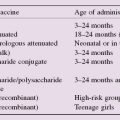By far the most common form of hypersensitivity is Gell and Coombs’ type I, which embraces such everyday allergic conditions as hay fever, eczema and urticaria but also the rare and terrifying anaphylactic reactions to bee stings, peanuts, penicillin, etc. In both cases the underlying mechanism is a sudden degranulation of mast cells (centre) with the release of inflammatory mediators, triggered by specific antibodies of the IgE class. It is therefore an example of acute inflammation (as already described in Fig. 7) but induced by the presence of a particular antigen rather than by injury or infection. With systemic release (anaphylaxis) there is bronchospasm, vomiting, skin rashes, oedema of the nose and throat, and vascular collapse, sometimes fatal, while with more localized release one or other of these symptoms predominates, depending on the site of exposure to the antigen. Type I hypersensitivity also underlies many cases of asthma, where continuous triggering of local inflammation leads to hypersensitivity of the lung wall and consequent prolonged bronchoconstriction and airway obstruction.
Antigens that can trigger these reactions are known as ‘allergens’. Allergens are often small molecular weight proteins (e.g. insect enzymes) or molecules that bind to host proteins (e.g. penicillins). People who suffer unduly from allergy usually have raised levels of IgE in their blood and are called ‘atopic’, a trait that is usually inherited, at least 12 genes being involved. As worm antigens are among the most powerful allergens, the existence of this unpleasant and apparently useless form of immune response has been assumed to date from a time when worm infections were a serious evolutionary threat. Inflammation itself, of course, is an invaluable part of the response to injury and infection, and where injury is minimal (e.g. worms in the gut), IgE offers a rapid and specific trigger for increasing access of blood cells, etc. to the area. It is important to note that the term ‘allergy’ is sometimes used more loosely to describe any adverse response to environmental stimuli, such as allergy to fungal spores experienced by some farmers, which has a totally different immunological basis, or food ‘allergies’, some of which do not involve the immune system at all.
There is a close link between inflammation and the emotions via the autonomic nervous system, through the influence of the sympathetic (α and β) and parasympathetic (γ) receptors on intracellular levels of the cyclic nucleotides adenosine monophosphate (AMP) and guanosine monophosphate (GMP), which in turn regulate cell function – in the case of mast cells, mediator release (see Fig. 25). Note also that mast cell degranulation can be triggered directly by tissue injury (see Fig. 7) and complement activation (see Fig. 6), and by some bacteria.
IgE
Stay updated, free articles. Join our Telegram channel

Full access? Get Clinical Tree




